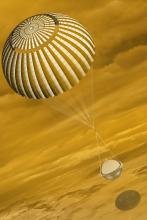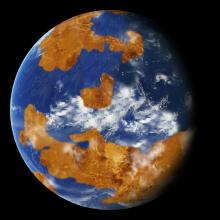Listen to today's episode of StarDate on the web the same day it airs in high-quality streaming audio without any extra ads or announcements. Choose a $8 one-month pass, or listen every day for a year for just $30.
You are here
More Moon, Mars, Venus
For the scientists who study volcanoes, Venus would be the equivalent of Disneyworld. About 1600 volcanoes pockmark the planet’s surface. Most of them are extinct, but a few may still be active. And thousands of structures that are related to volcanoes dot the surface as well. They include formations that look like rings, pancakes, and even starbursts.
Perhaps the most intriguing formations are known as arachnoids. They consist of a series of concentric rings with dozens or hundreds of lines radiating away from them. That makes them look like giant spiders clinging to vast webs. Scientists have cataloged more than 250 of them.
How arachnoids form is a bit of a mystery. One study, though, says they most likely are created when blobs of molten rock bubble up from the planet’s mantle, which is the layer below the crust. As it pushes up it spreads outward, splitting the crust. That forms the rings, as well as cracks that radiate outward. Molten rock then fills the cracks, forming dikes that can be more than a hundred miles long.
Over time, the process may continue, forming even bigger features — rings and starbursts that may consume the Venusian spiderwebs.
And Venus is in great view right now. It’s low in the west at nightfall, and shines as the “evening star.” Tonight, the crescent Moon stands well to its upper left. And the fainter planet Mars stands beside the Moon, completing a beautiful alignment in the evening sky.
Script by Damond Benningfield





